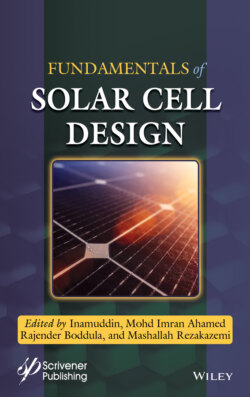Читать книгу Fundamentals of Solar Cell Design - Rajender Boddula - Страница 2
Table of Contents
Оглавление1 Cover
2 Title page
3 Copyright
4 Preface
5 1 Organic Solar Cells 1.1 Introduction 1.2 Classification of Solar Cells 1.3 Solar Cell Structure 1.4 Photovoltaic Parameters or Terminology Used in BHJOSCs 1.5 Some Basic Design Principles/Thumb Rules Associated With Organic Materials Required for BHJOSCs 1.6 Recent Research Advances in Small-Molecule Acceptor and Polymer Donor Types 1.7 Recent Research Advances in All Small-Molecule Acceptor and Donor Types 1.8 Conclusion Acknowledgement References
6 2 Plasmonic Solar Cells 2.1 Introduction 2.2 Principles and Working Mechanism of Plasmonic Solar Cells 2.3 Important Optical Properties 2.4 Advancements in Plasmonic Solar Cells 2.5 Conclusion and Future Aspects Acknowledgements References
7 3 Tandem Solar Cell List of Abbreviations 3.1 Introduction 3.2 Review of Organic Tandem Solar Cell 3.3 Review of Inorganic Tandem Solar Cell 3.4 Conclusion References
8 4 Thin-Film Solar Cells 4.1 Introduction 4.2 Why Thin-Film Solar Cells? 4.3 Amorphous Silicon 4.4 Cadmium Telluride 4.5 Copper Indium Diselenide Solar Cells 4.6 Comparison Between Flexible a-Si:H, CdTe, and CIGS Cells and Applications 4.7 Conclusion References
9 5 Biohybrid Solar Cells Abbreviations 5.1 Introduction 5.2 Photovoltaics 5.3 Solar Cells 5.4 Biohybrid Solar Cells 5.5 Role of Photosynthesis 5.6 Plant-Based Biohybrid Devices 5.7 Dye-Sensitized Solar Cells 5.8 Polymer and Semiconductors-Based Biohybrid Solar Cells 5.9 Conclusion References
10 6 Dye-Sensitized Solar Cells 6.1 Introduction 6.2 Cell Architecture and Working Mechanism 6.3 Fabrication of Simple DSSC in Lab Scale 6.4 Electrodes 6.5 Counter Electrode 6.6 Blocking Layer 6.7 Electrolytes Used 6.8 Commonly Used Natural Dyes in DSSC 6.9 Calculations 6.10 Conclusion References
11 7 Characterization and Theoretical Modeling of Solar Cells 7.1 Introduction 7.2 Classification of SC 7.3 Working Principle of DSSC 7.4 Operation Principle of DSSC 7.5 Photovoltaic Parameters 7.6 Theoretical and Computational Methods 7.7 Conclusion References
12 8 Efficient Performance Parameters for Solar Cells 8.1 Introduction 8.2 Solar Radiation Intensity Calculation 8.3 Methodology 8.4 Conclusions References
13 9 Practices to Enhance Conversion Efficiencies in Solar Cell 9.1 Introduction 9.2 Basics on Conversion Efficiency 9.3 Approaches for Improving Conversion Efficiencies in Solar Cells 9.4 Conclusion Acknowledgements References
14 10 Solar Cell Efficiency Energy Materials 10.1 Introduction 10.2 Solar Cell Efficiency 10.3 Historical Development of Solar Cell Materials 10.4 Solar Cell Materials and Efficiencies 10.5 Conclusion and Prospects References
15 11 Analytical Tools for Solar Cell 11.1 Introduction 11.2 Transient Absorption Spectroscopy 11.3 Electron Tomography 11.4 Conductive Atomic Force Microscopy (C-AFM) 11.5 Kelvin Probe Force Microscopy 11.6 Field Emission Scanning Electron Microscopy and Transmission Electron Microscopy 11.7 Conclusion References
16 12 Applications of Solar Cells 12.1 Introduction 12.2 An Overview on Photovoltaic Cell 12.3 Applications of Solar Cells 12.4 Conclusion and Summary References
17 13 Challenges of Stability in Perovskite Solar Cells 13.1 Introduction 13.2 Degradation Phenomena and Stability Measures in Perovskite 13.3 Stability-Interface Interplay 13.4 Effect of Selective Contacts on Stability 13.5 Conclusion References
18 14 State-of-the-Art and Prospective of Solar Cells Acronyms 14.1 Introduction 14.2 State-of-the-Art of Solar Cells 14.3 Prospective of Solar Cells 14.4 Conclusion References
19 15 Semitransparent Perovskite Solar Cells 15.1 Introduction 15.2 Device Architectures 15.3 Optical Assessment 15.4 Materials 15.5 Applications 15.6 Conclusion References
20 16 Flexible Solar Cells 16.1 Introduction 16.2 Materials for FSCs 16.3 Thin-Film Deposition 16.4 Characterizations for FSCs 16.5 Issues in FSCs 16.6 Performance Comparison of RSCs and FSCs 16.7 Applications of Flexible Solar Cell 16.8 Conclusion References
21 Index
22 Also of Interest
23 End User License Agreement
